warning YAMAHA YZF-R6 2016 User Guide
[x] Cancel search | Manufacturer: YAMAHA, Model Year: 2016, Model line: YZF-R6, Model: YAMAHA YZF-R6 2016Pages: 112, PDF Size: 2.57 MB
Page 24 of 112
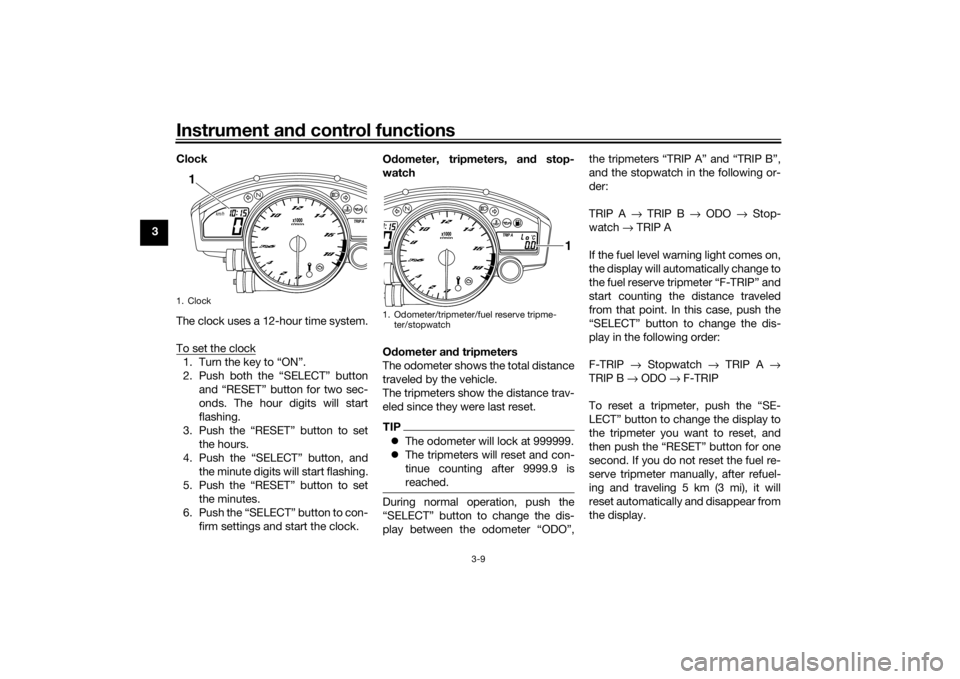
Instrument and control functions
3-9
3 Clock
The clock uses a 12-hour time system.
To set the clock
1. Turn the key to “ON”.
2. Push both the “SELECT” button
and “RESET” button for two sec-
onds. The hour digits will start
flashing.
3. Push the “RESET” button to set the hours.
4. Push the “SELECT” button, and the minute digits will start flashing.
5. Push the “RESET” button to set the minutes.
6. Push the “SELECT” button to con- firm settings and start the clock. O
dometer, tripmeters, an d stop-
watch
O dometer an d tripmeters
The odometer shows the total distance
traveled by the vehicle.
The tripmeters show the distance trav-
eled since they were last reset.
TIP The odometer will lock at 999999.
The tripmeters will reset and con-
tinue counting after 9999.9 is
reached.During normal operation, push the
“SELECT” button to change the dis-
play between the odometer “ODO”, the tripmeters “TRIP A” and “TRIP B”,
and the stopwatch in the following or-
der:
TRIP A
→ TRIP B → ODO → Stop-
watch → TRIP A
If the fuel level warning light comes on,
the display will automatically change to
the fuel reserve tripmeter “F-TRIP” and
start counting the distance traveled
from that point. In this case, push the
“SELECT” button to change the dis-
play in the following order:
F-TRIP → Stopwatch → TRIP A →
TRIP B → ODO → F-TRIP
To reset a tripmeter, push the “SE-
LECT” button to change the display to
the tripmeter you want to reset, and
then push the “RESET” button for one
second. If you do not reset the fuel re-
serve tripmeter manually, after refuel-
ing and traveling 5 km (3 mi), it will
reset automatically and disappear from
the display.
1. Clock
km/h
TRIP A
1
1. Odometer/tripmeter/fuel reserve tripme- ter/stopwatch
TRIP A
˚C
1
U2CXE2E0.book Page 9 Tuesday, June 9, 2015 5:04 PM
Page 26 of 112

Instrument and control functions
3-11
3
TIP When the air intake temperature is
below –9 °C, “LO” will be dis-
played.
Even when the air intake tempera-
ture is displayed, the coolant tem-
perature warning light comes on if
the engine overheats.
When the key is turned to “ON”,
the coolant temperature is auto-
matically displayed, even if the air
intake temperature was displayed
prior to turning the key to “OFF”.
When the air intake temperature
display is selected, “A” is dis-
played for one second, and then
“A” and the air intake temperature
are displayed.
Self- dia gnosis device
This model is equipped with a self-di-
agnosis device for various electrical
circuits. If a problem is detected in any
of those circuits, the engine trouble
warning light will come on and the dis-
play will indicate an error code. If the
display indicates any error codes, note
the code number and have a Yamaha
dealer check the vehicle.
The self-diagnosis device also detects
problems in the immobilizer system
circuits. If a problem is detected in the
immobilizer system circuits, the immo- bilizer system indicator light will flash
and the display will indicate an error
code.
TIPIf the display indicates error code 52,
this could be caused by transponder
interference. If this error code appears,
try the following:1. Use the code re-registering key to
start the engine.TIPMake sure there are no other immobi-
lizer keys close to the main switch, and
do not keep more than one immobilizer
key on the same key ring! Immobilizer
system keys may cause signal interfer-
ence, which may prevent the engine
from starting.2. If the engine starts, turn it off andtry starting the engine with the
standard keys.
3. If one or both of the standard keys do not start the engine, take the
vehicle, the code re-registering
key and both standard keys to a
Yamaha dealer and have the stan-
dard keys re-registered.
1. Immobilizer system indicator light
2. Engine trouble warning light “ ”
3. Error code display
321
U2CXE2E0.book Page 11 Tuesday, June 9, 2015 5:04 PM
Page 29 of 112

Instrument and control functions
3-14
3
EAU1234H
Han dle bar switchesLeft Ri
ght
EAU12351
Pass switch “ ”
Press this switch to flash the headlight.
EAU12401
Dimmer switch “ / ”
Set this switch to “ ” for the high
beam and to “ ” for the low beam.
EAU12461
Turn si gnal switch “ / ”
To signal a right-hand turn, push this
switch to “ ”. To signal a left-hand
turn, push this switch to “ ”. When
released, the switch returns to the cen- ter position. To cancel the turn signal
lights, push the switch in after it has re-
turned to the center position.
EAU12501
Horn switch “ ”
Press this switch to sound the horn.
EAU12661
En
gine stop switch “ / ”
Set this switch to “ ” before starting
the engine. Set this switch to “ ” to
stop the engine in case of an emergen-
cy, such as when the vehicle overturns
or when the throttle cable is stuck.
EAU12713
Start switch “ ”
Push this switch to crank the engine
with the starter. See page 5-1 for start-
ing instructions prior to starting the en-
gine.
EAU41701
The engine trouble warning light will
come on when the key is turned to
“ON” and the start switch is pushed,
but this does not indicate a malfunc-
tion.
1. Pass switch “ ”
2. Dimmer switch “ / ”
3. Turn signal switch “ / ”
4. Horn switch “ ”
5. Hazard switch “ ”
1. Engine stop switch “ / ”
2. Start switch “ ”
U2CXE2E0.book Page 14 Tuesday, June 9, 2015 5:04 PM
Page 32 of 112
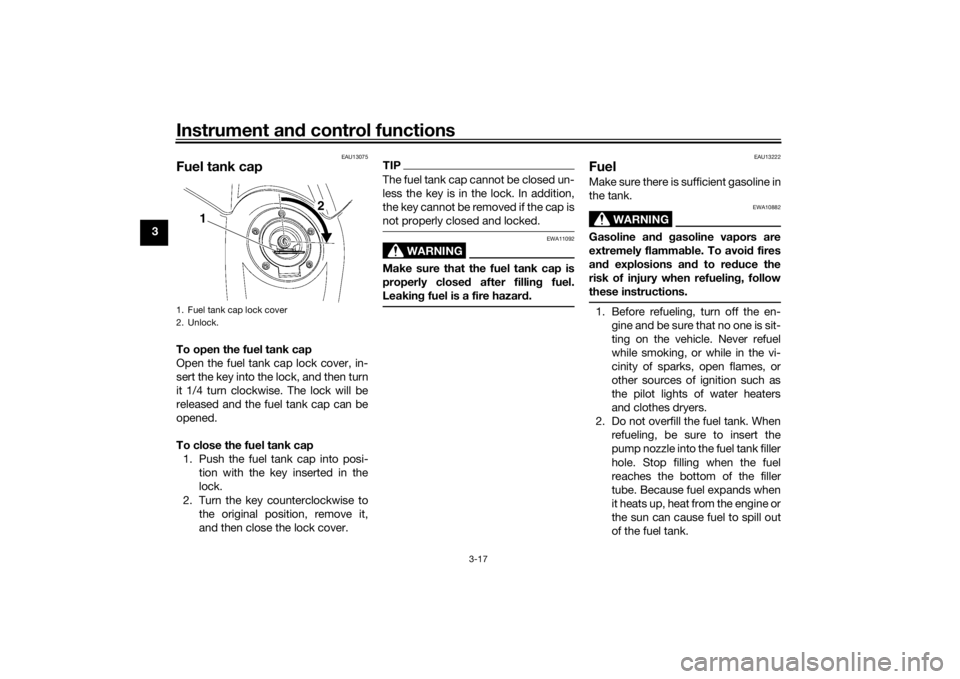
Instrument and control functions
3-17
3
EAU13075
Fuel tank capTo open the fuel tank cap
Open the fuel tank cap lock cover, in-
sert the key into the lock, and then turn
it 1/4 turn clockwise. The lock will be
released and the fuel tank cap can be
opened.
To close the fuel tank cap
1. Push the fuel tank cap into posi- tion with the key inserted in the
lock.
2. Turn the key counterclockwise to the original position, remove it,
and then close the lock cover.
TIPThe fuel tank cap cannot be closed un-
less the key is in the lock. In addition,
the key cannot be removed if the cap is
not properly closed and locked.
WARNING
EWA11092
Make sure that the fuel tank cap is
properly close d after fillin g fuel.
Leakin g fuel is a fire hazar d.
EAU13222
FuelMake sure there is sufficient gasoline in
the tank.
WARNING
EWA10882
Gasoline an d g asoline vapors are
extremely flammab le. To avoid fires
an d explosions an d to re duce the
risk of injury when refuelin g, follow
these instructions.1. Before refueling, turn off the en- gine and be sure that no one is sit-
ting on the vehicle. Never refuel
while smoking, or while in the vi-
cinity of sparks, open flames, or
other sources of ignition such as
the pilot lights of water heaters
and clothes dryers.
2. Do not overfill the fuel tank. When refueling, be sure to insert the
pump nozzle into the fuel tank filler
hole. Stop filling when the fuel
reaches the bottom of the filler
tube. Because fuel expands when
it heats up, heat from the engine or
the sun can cause fuel to spill out
of the fuel tank.
1. Fuel tank cap lock cover
2. Unlock.
1 2
U2CXE2E0.book Page 17 Tuesday, June 9, 2015 5:04 PM
Page 33 of 112
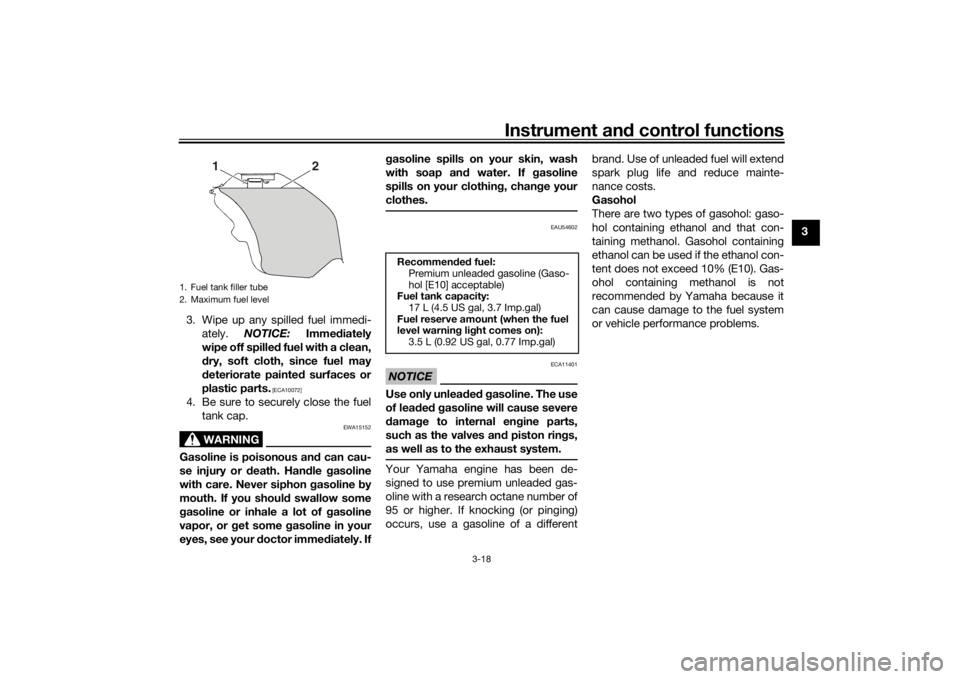
Instrument and control functions
3-18
3
3. Wipe up any spilled fuel immedi- ately. NOTICE: Immediately
wipe off spille d fuel with a clean,
d ry, soft cloth, since fuel may
d eteriorate painte d surfaces or
plastic parts.
[ECA10072]
4. Be sure to securely close the fuel tank cap.
WARNING
EWA15152
Gasoline is poisonous an d can cau-
se injury or death. Han dle gasoline
with care. Never siphon gasoline by
mouth. If you shoul d swallow some
g asoline or inhale a lot of gasoline
vapor, or get some g asoline in your
eyes, see your d octor immediately. If g
asoline spills on your skin, wash
with soap an d water. If gasoline
spills on your clothin g, chan ge your
clothes.
EAU54602
NOTICE
ECA11401
Use only unlea ded g asoline. The use
of lead ed g asoline will cause severe
d amag e to internal en gine parts,
such as the valves an d piston rin gs,
as well as to the exhaust system.Your Yamaha engine has been de-
signed to use premium unleaded gas-
oline with a research octane number of
95 or higher. If knocking (or pinging)
occurs, use a gasoline of a different brand. Use of unleaded fuel will extend
spark plug life and reduce mainte-
nance costs.
Gasohol
There are two types of gasohol: gaso-
hol containing ethanol and that con-
taining methanol. Gasohol containing
ethanol can be used if the ethanol con-
tent does not exceed 10% (E10). Gas-
ohol containing methanol is not
recommended by Yamaha because it
can cause damage to the fuel system
or vehicle performance problems.
1. Fuel tank filler tube
2. Maximum fuel level
2
1
Recommen ded fuel:
Premium unleaded gasoline (Gaso-
hol [E10] acceptable)
Fuel tank capacity:
17 L (4.5 US gal, 3.7 Imp.gal)
Fuel reserve amount (when the fuel
level warnin g li ght comes on):
3.5 L (0.92 US gal, 0.77 Imp.gal)
U2CXE2E0.book Page 18 Tuesday, June 9, 2015 5:04 PM
Page 34 of 112
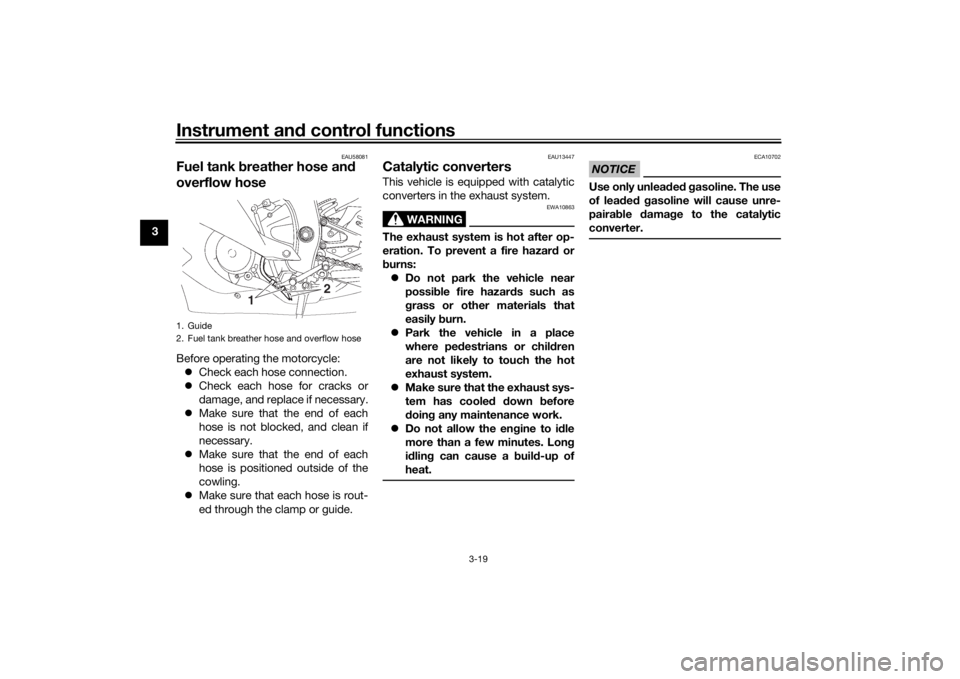
Instrument and control functions
3-19
3
EAU58081
Fuel tank breather hose an d
overflow hoseBefore operating the motorcycle:
Check each hose connection.
Check each hose for cracks or
damage, and replace if necessary.
Make sure that the end of each
hose is not blocked, and clean if
necessary.
Make sure that the end of each
hose is positioned outside of the
cowling.
Make sure that each hose is rout-
ed through the clamp or guide.
EAU13447
Catalytic converters This vehicle is equipped with catalytic
converters in the exhaust system.
WARNING
EWA10863
The exhaust system is hot after op-
eration. To prevent a fire hazar d or
b urns:
Do not park the vehicle near
possi ble fire hazard s such as
g rass or other materials that
easily burn.
Park the vehicle in a place
where ped estrians or chil dren
are not likely to touch the hot
exhaust system.
Make sure that the exhaust sys-
tem has coole d down before
d oin g any maintenance work.
Do not allow the en gine to id le
more than a few minutes. Lon g
i d lin g can cause a b uild-up of
heat.
NOTICE
ECA10702
Use only unlea ded g asoline. The use
of lead ed g asoline will cause unre-
pairab le damag e to the catalytic
converter.
1. Guide
2. Fuel tank breather hose and overflow hose
2
1
U2CXE2E0.book Page 19 Tuesday, June 9, 2015 5:04 PM
Page 36 of 112
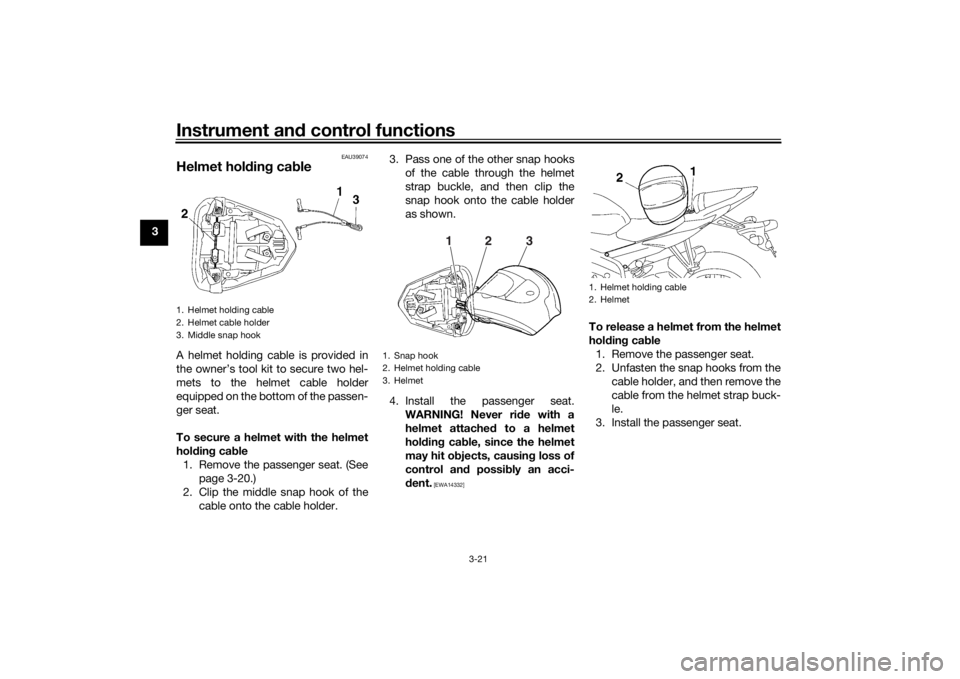
Instrument and control functions
3-21
3
EAU39074
Helmet hold ing ca bleA helmet holding cable is provided in
the owner’s tool kit to secure two hel-
mets to the helmet cable holder
equipped on the bottom of the passen-
ger seat.
To secure a helmet with the helmet
hol din g cab le
1. Remove the passenger seat. (See page 3-20.)
2. Clip the middle snap hook of the cable onto the cable holder. 3. Pass one of the other snap hooks
of the cable through the helmet
strap buckle, and then clip the
snap hook onto the cable holder
as shown.
4. Install the passenger seat. WARNING! Never ri de with a
helmet attached to a helmet
hol din g cab le, since the helmet
may hit o bjects, causin g loss of
control an d possi bly an acci-
d ent.
[EWA14332]
To release a helmet from the helmet
hol din g cab le
1. Remove the passenger seat.
2. Unfasten the snap hooks from the cable holder, and then remove the
cable from the helmet strap buck-
le.
3. Install the passenger seat.
1. Helmet holding cable
2. Helmet cable holder
3. Middle snap hook
1. Snap hook
2. Helmet holding cable
3. Helmet
1
2
3
1. Helmet holding cable
2. Helmet
U2CXE2E0.book Page 21 Tuesday, June 9, 2015 5:04 PM
Page 37 of 112

Instrument and control functions
3-22
3
EAU39672
Rear view mirrorsThe rear view mirrors of this vehicle
can be folded forward or backward for
parking in narrow spaces. Fold the mir-
rors back to their original position be-
fore riding.
WARNING
EWA14372
Be sure to fol d the rear view mirrors
b ack to their ori ginal position before
ri din g.
EAU70520
A djustin g the front fork
WARNING
EWA10181
Always a djust both fork leg s equally,
otherwise poor han dlin g an d loss of
sta bility may result.This front fork is equipped with spring
preload adjusting bolts, rebound
damping force adjusting screws, com-
pression damping force adjusting bolts
(for fast compression damping) and
compression damping force adjusting
bolts (for slow compression damping).NOTICE
ECA10102
To avoi d d amag ing the mechanism,
d o not attempt to turn b eyond the
maximum or minimum settin gs.Sprin g preloa d
To increase the spring preload and
thereby harden the suspension, turn
the adjusting bolt on each fork leg in di-
rection (a). To decrease the spring pre-
load and thereby soften the
suspension, turn the adjusting bolt on
each fork leg in direction (b). The spring preload setting is deter-
mined by measuring distance A,
shown in the illustration. The shorter
distance A is, the higher the spring pre-
load; the longer distance A is, the lower
the spring preload.
1. Riding position
2. Parking position
2
2
1
2
2
1
1. Spring preload adjusting bolt
1. Distance A
1
(a) (b)
1
U2CXE2E0.book Page 22 Tuesday, June 9, 2015 5:04 PM
Page 41 of 112

Instrument and control functions
3-26
3
Compression damping force (for slow
compression damping)To increase the compression damping
force and thereby harden the com-
pression damping, turn the adjusting
screw in direction (a). To decrease the
compression damping force and there-
by soften the compression damping,
turn the adjusting screw in direction (b).
TIPTo obtain a precise adjustment, it is
advisable to check the actual total
number of clicks or turns of each
damping force adjusting mechanism. This adjustment range may not exactly
match the specifications listed due to
small differences in production.
WARNING
EWA10222
This shock a
bsor ber assem bly con-
tains hig hly pressurize d nitro gen
g as. Rea d an d un derstan d the fol-
lowin g information before han dlin g
the shock a bsor ber assem bly.
Do not tamper with or attempt
to open the cylind er assembly.
Do not su bject the shock a b-
sor ber assem bly to an open
flame or other hi gh heat source.
This may cause the unit to ex-
plo de due to excessive gas
pressure.
Do not deform or damag e the
cylin der in any way. Cylin der
d ama ge will result in poor
d ampin g performance.
Do not dispose of a d amaged or
worn-out shock a bsor ber as-
sem bly y
ourself. Take the shock
a b sor ber assem bly to a Yamaha
d ealer for any service.
Compression dampin g setting (for
fast compression dampin g):
Minimum (soft): 5.5 turn(s) in direction (b)*
Standard: 3 turn(s) in direction (b)*
Maximum (hard):
0 turn(s) in direction (b)*
* With the adjusting bolt fully turned in direction (a)
1. Compression damping force adjusting
screw (for slow compression damping)
Compression dampin g setting (for
slow compression dampin g):
Minimum (soft):
18 click(s) in direction (b)*
Standard: 16 click(s) in direction (b)*
Maximum (hard): 1 click(s) in direction (b)*
* With the adjusting bolt fully turned
in direction (a)
1
(a)
(b)
U2CXE2E0.book Page 26 Tuesday, June 9, 2015 5:04 PM
Page 43 of 112

Instrument and control functions
3-28
3
EAU15306
Si destan dThe sidestand is located on the left
side of the frame. Raise the sidestand
or lower it with your foot while holding
the vehicle upright.TIPThe built-in sidestand switch is part of
the ignition circuit cut-off system,
which cuts the ignition in certain situa-
tions. (See the following section for an
explanation of the ignition circuit cut-
off system.)
WARNING
EWA10242
The vehicle must not b e ridden with
the si destan d d own, or if the si de-
stan d cannot b e properly move d up
(or does not stay up), otherwise the
si destan d coul d contact the g round
an d d istract the operator, resultin g
in a possi ble loss of control.
Yamaha’s i gnition circuit cut-off
system has been desi gne d to assist
the operator in fulfilling the respon-
si bility of raisin g the si destan d b e-
fore startin g off. Therefore, check this system re
gularly an d have a
Yamaha dealer repair it if it does not
function properly.
EAU44893
I g nition circuit cut-off systemThe ignition circuit cut-off system
(comprising the sidestand switch,
clutch switch and neutral switch) has
the following functions.
It prevents starting when the
transmission is in gear and the
sidestand is up, but the clutch le-
ver is not pulled.
It prevents starting when the
transmission is in gear and the
clutch lever is pulled, but the side-
stand is still down.
It cuts the running engine when
the transmission is in gear and the
sidestand is moved down.
Periodically check the operation of the
ignition circuit cut-off system accord-
ing to the following procedure.
U2CXE2E0.book Page 28 Tuesday, June 9, 2015 5:04 PM